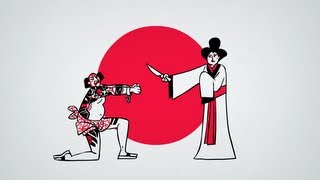(单词翻译:单击)
Many elements of traditional Japanese culture, such as cuisine and martial arts, are well-known throughout the world.
许多传统日本文化中的元素,比如说饮食、武术,都在世界上享有盛名。
Kabuki, a form of classical theater performance, may not be as well understood in the West
歌舞伎是一种日本传统的戏剧表演形式,它也许并不很像其他日本元素那样被西方文化所理解,
but has evolved over 400 years to still maintain influence and popularity to this day.
但其自身已经经过了超过400年的发展历程,直到现在还保有很高的地位和影响力。
The word Kabuki is derived from the Japanese verb kabuku, meaning out of the ordinary or bizarre.
歌舞伎这三个字是源于日语“倾”,它代表与众不同,或有些不寻常的表演。
Its history began in early 17th century Kyoto, where a shrine maiden named Izumo no Okuni
它的历史可以追溯到17世纪的京都,京都当时有一位很出名的巫女,叫做出云阿国,
would use the city's dry Kamo Riverbed as a stage to perform unusual dances for passerby,
她当时将一条已经干涸的河床当做舞台场所,为过路人提供与众不同的舞蹈表演。
who found her daring parodies of Buddhist prayers both entertaining and mesmerizing.
她的舞蹈有时会极其夸张地模仿佛教徒朝拜的样子,极具娱乐性,也让人过目难忘。
Soon other troops began performing in the same style,
很快的,其他的一些表演团也开始演出相同风格的舞蹈表演,
and Kabuki made history as Japan's first dramatic performance form catering to the common people.
歌舞伎从此成为日本历史上第一个为娱乐普罗大众而生的戏剧表演。
By relying on makeup, or keshou, and facial expressions instead of masks
借住精妙的化妆技巧(日语叫做Keshou),此类表演用丰富的面部表情代替了僵硬的面具,
and focusing on historical events and everyday life rather than folk tales,
而且主要关注历史事件及老百姓的日常生活,而不是民谣桥段,
Kabuki set itself apart from the upper-class dance theater form known as Noh
歌舞伎自此与上流社会的舞蹈剧(也叫做Noh)的形式区分开来,
and provided a unique commentary on society during the Edo period.
还很好地体现了当时社会(江户时代)的面貌。
At first, the dance was practiced only by females and commonly referred to as Onna-Kabuki.
最初的时候只有女性舞者,日语称为Onna-Kabuki。
It soon evolved to an ensemble performance and became a regular attraction at tea houses,
但不久它就演变成了一项全面的表演形式,并成为了当时茶楼的固定节目,
drawing audiences from all social classes.
吸引了来自社会各个阶层的观众。
At this point, Onna-Kabuki was often risque as geishas performed not only to show off their singing and dancing abilities
在那时,女性舞者还是会被认为是从事“不洁”的工作,因为艺妓不仅仅要展现她们的歌喉及舞技,
but also to advertise their bodies to potential clients.
还要用身体去吸引潜在的观众们。
A ban by the conservative Tokugawa shogunate in 1629 led to the emergence of Wakashu-Kabuki with young boys as actors.
保守派的徳川幕府的禁令在1629年推动创建了若众歌舞伎,全是由未成年的男孩来表演。

But when this was also banned for similar reasons,
但它后来也因为类似的原因被禁,
there was a transition to Yaro-Kabuki, performed by men,
之后就过渡到了野郎歌舞伎,也就是全是成年男性表演的歌舞伎,
necessitating elaborate costumes and makeup for those playing female roles, or onnagata.
迫使这些成年男子化浓妆、着女服来表演女性角色,日语称之为“女形”。
Attempts by the government to control Kabuki didn't end with bans on the gender or age of performers.
日本政府为了控制歌舞伎的发展所做的努力,并不仅限在表演者的性别和年龄。
The Tokugawa military group, or Bakufu, was fueled by Confucian ideals
徳川的军队,也叫做幕府,受到孔子文化很深的影响,
and often enacted sanctions on costume fabrics, stage weaponry, and the subject matter of the plot.
他们常常颁布很多法令来限制戏服材料、舞台设计还有情节主题。
At the same time, Kabuki became closely associated with and influenced by Bunraku, an elaborate form of puppet theater.
与此同时,歌舞伎受到了文乐木偶戏的影响,然后与之结合,从而形成了木偶剧场。
Due to these influences, the once spontaneous, one-act dance
由于上述影响,原本非常即兴且为单幕舞的表演,
evolved into a structured, five-act play often based on the tenets of Confucian philosophy.
慢慢演化成了有紧密结构的五幕的表演,其主题常常是有关孔子哲学的思想。
Before 1868, when the Tokugawa shogunate fell and Emperor Meiji was restored to power,
在1868年之前,徳川幕府衰落,明治皇帝重拾大权,
Japan had practiced isolation from other countries, or Sakoku.
日本开始实行闭关锁国的政策,也成为“日本锁国”。
And thus, the development of Kabuki had mostly been shaped by domestic influences.
从那以后,歌舞伎的发展主要受国内文化的影响。
But even before this period, European artists, such as Claude Monet,
但这个时期之前,来自欧洲的艺术家,比如克劳德·莫奈,
had become interested in and inspired by Japanese art, such as woodblock prints, as well as live performance.
对于日本艺术非常着迷且受到其很多启发,比如说日本的木版镌刻还有现场表演。
After 1868, others such as Vincent van Gogh and composer Claude Debussy began to incorporate Kabuki influences in their work,
1868年后,其他一些艺术家,比如文森特·梵高,还有作曲家克劳德·德彪西,都将歌舞伎融入到了他们的艺术创作,
while Kabuki itself underwent much change and experimentation to adapt to the new modern era.
而此时歌舞伎本身也在不断经历着变革,以适应新摩登时代的到来。
Like other traditional art forms, Kabuki suffered in popularity in the wake of World War II.
与其他传统艺术形式相同,歌舞伎在世界第二次大战的动荡期陷入发展低谷。
But innovation by artists such as director Tetsuji Takechi led to a resurgence shortly after.
但日本艺术家们不断创新,比如导演武智鉄二在不久后再次振兴了歌舞伎。
Indeed, Kabuki was even considered a popular form of entertainment amongst American troops stationed in Japan
当时,歌舞伎甚至在驻日本的美军中被当做一种非常流行的娱乐形式,
despite initial U.S. censorship of Japanese traditions.
即使美国最初是对日本传统文化严格审查的。
Today, Kabuki still lives on as an integral part of Japan's rich cultural heritage,
如今,歌舞伎依然不断发展,它是日本璀璨文化遗产不可分割的一块瑰宝,
extending its influence beyond the stage to television, film, and anime.
它的影响力远超越舞台,已经延伸到电视、电影、动画。
The art form pioneered by Okuni continues to delight audiences with the actors' elaborate makeup,
阿国开创的歌舞伎一直愉悦着观众,其方式是通过表演者精致的妆容
extravagant and delicately embroidered costumes, and the unmistakable melodrama of the stories told on stage.
浮华精美的戏服和通过舞台诉说的动人的故事情节。


